Preprint
Article
An Interactive Knowledge Platform for Promoting Sustainable Tourism and Other SDGs
This version is not peer-reviewed.
Submitted:
04 November 2024
Posted:
05 November 2024
You are already at the latest version
Abstract
The interactive knowledge platform, FaST, can be used by general public, various government and non-government agencies, and businesses for the advancement of the local economy in the community, creating jobs for community members, increasing income potentials, and thus alleviating poverty; and provide enhanced educational opportunities, and can also indirectly benefit to improve health and other prospects.
Keywords:
Sustainable Tourism
; Sustainable Development Goals
; Interactive platform
; Faith-based tourism
; Information System
; Thailand
1. Introduction
Sustainable Development Goals (SDGs) are a direction for national development that United Nations member countries have signed to jointly develop society, economy, and environment. There are a total of 17 main goals, 169 targets, and nearly 250 development indicators to track the progress of these goals. Member countries have adopted these goals to formulate sustainable development policies according to their respective contexts. To align with and achieve the SDGs, the government in Thailand has applied sustainable development policies in various areas, from government to community levels. One policy that contributes to achieving the goal is Thailand's tourism industry, that connects people with the environment, historical sites, culture, traditions, and beliefs through various businesses. Thus, Thailand aims to build a holistic tourism system that emphasizes adding value to tourism.
The economic slowdown of the country since the outbreak of the COVID-19 pandemic has resulted in an economic growth rate that is continuously lower than its potential. The Thai government continues to prioritize the tourism-driven economy in 2024, marking it as a year of economic recovery. Sustainable tourism is a form of tourism that Thailand has promoted and publicised to attract both Thai and foreign tourists. This is because Thailand has outstanding natural resources, traditions, cultures, and ways of life that can tell stories and create interest for tourists [1]. It contributes to the creation of added economic value for the area and community, fostering long-term sustainability for the community. This sustainability takings into account nature, communities, traditions, and ways of life related to tourism, ensuring their preservation and development without destroying or damaging tourist attractions. Sustainable tourism requires instilling awareness in stakeholders, including tourists, local people, entrepreneurs, and agencies related to tourism. Currently, the United Nations Tourism Organization promotes and supports various forms of tourism, including community-based tourism, green tourism, and faith-based tourism. According to the Association of Domestic travel [2] seven criteria define the basic principles of sustainable tourism development: carrying capacity and local participation, fair distribution of benefits to local areas, quality of experience, education and understanding of local areas, local architecture and materials, integration of sustainable tourism to local, regional, and national plans, and information and monitoring.
The statistics of Thai tourism in 2019-2023, shows that the number of tourists increased by an average of 10% per year, demonstrating the growth of e tourism [3] Therefore, Thailand is planning to develop sustainable tourism and has included it in the national tourism development plan. In addition, the report of the Office of Trade Policy and Strategy (OTPS), Ministry of Commerce [4], shows the statistics of 11,000 tourists aged 18 and over from 11 countries viz. Canada, United States, Mexico, Brazil, United Kingdom, France, Germany, Australia, India, China, and Japan). Economist impact & AirBnB [5] found that up to 90% of tourists made their travel decisions based on sustainability, with 69% choosing tourism that positively impacts the environment, 66% supporting the local economy, and 65% showing interest in local culture and community. It is evident that a growing number of tourists in many countries are choosing their tourist attractions based on sustainability. However, at the same time, the increase in the number of tourists also affects many countries, communities or natural resources and the environment of various tourist attractions. Therefore, the Office of Tourism Policy and Strategy developed the BCG economic model that has been applied to tourism to respond to tourism behaviours, values, and needs that emphasise sustainability and development of sustainable tourism services [6].
Cultural tourism is a form of sustainable tourism that aims to present knowledge or pride in culture, history, or various festivals and traditions related to the well-being of society, including the way of life of local people [7]. Examples of cultural tourism in Thailand that are well-known to both Thais and foreigners are the Songkran Festival, the Loi Krathong Festival, or various historical tourist attractions, such as Ayutthaya Historical Park. Cultural tourism management necessitates the community's cooperation in determining or driving tourism, both as the owner of the resource and as a stakeholder. This involves using local resources as a cost or factor in tourism management appropriately, and developing the potential of community members to have knowledge, skills, decision-making, planning, or various operations to benefit the community sustainably. Therefore, various community operations require appropriate and sufficient information for planning and decision-making, enabling them to effectively manage tourism and prepare for the arrival of tourists. At the same time, tourists nowadays often check information to support their decision-making before traveling. Therefore, preparing information for providing services to users is essential.
There are two main categories of faith tourism: 1) Faith tourism by pilgrimage, by traveling to important religious sites with the purpose of realising the value or worshiping sacred objects, or participating in religious activities, rituals or important traditions, such as participating in the candle procession of Ubon Ratchathani Province, traveling to Wat Chedi (Ai Khai) in Nakhon Si Thammarat Province to ask for blessings for good fortune, including renting Ai Khai, a sacred object of Wat Chedi or Wat Si Chum in Sukhothai Province, that is one of the legends of the “talking Buddha statue”, which was a strategy of King Naresuan the Great to build morale and encouragement for soldiers before going to war, including being a place for the water pouring ceremony, etc.; and 2) Faith tourism that involves visiting important religious historical sites, such as Wat Phra Sri Rattana Satsadaram, Wat Phra That Doi Suthep Ratchaworawihan in Chiang Mai Province, Wat Rong Khun in Chiang Rai Province, or Wat Phra That Pha Sorn Kaew in Phetchabun Province. Important Thai temples are beautiful, and they showcase Thai arts and culture, attracting many Thai and foreign tourists and helping to increase the country’s economic value. As seen from the report of Matichon News Agency [8], there were 22,064,968 visitors to the temple between January and October 2023, with the majority of foreign tourists coming from Malaysia, followed by China, South Korea, India, and Russia, respectively. According to the statistics from the Ministry of Commerce (2019) [9], religious tourism has the potential to generate a revenue of 10,800 million baht in the economic system. The popularity of religious tourism has been steadily increasing across all countries. This trend is consistent with the Future Markets Insight report [10] which predicts that the economic value of religious tourism worldwide will reach approximately 13.7 billion US dollars in 2022. This figure is expected to increase to 40.9 billion US dollars in 2033, a three-fold increase in just 10 years [10]. The government's support for religious tourism, coupled with the provision of useful information, will assist tourists in selecting temples and nearby tourist attractions, as well as other factors such as reputation, popularity, transportation, accommodations, and restaurants, to support their decision-making process.
In Thailand, faith tourism is widely available across the nation. The Tourism Authority of Thailand [11] has compiled a list of 60 faith tourism destinations nationwide to promote faith tourism and published them in the form of an e-book. However, the e-book only presents static information specific to that faith site.
The key aim of the research reported in this paper is to demonstrate how linking various data sources, and presenting related information through an interactive platform, adds value to existing information, enabling a variety of use cases by connecting places, heritage, festivals, beliefs, related artefacts like amulets, and individuals, government agencies, and businesses within the community. In addition to promoting faith tourism, the FaST platform will also benefit the local government agencies enabling them to use the information on the platform to plan local development for sustainable growth including, improving the quality of life, stimulate the local economy, and create jobs for local people (Figure1).
The conceptual map in Figure 1 indicates that faith-based tourism activities, and the associated data, can contribute to achieving various sustainable development objectives. The platform can be used by diverse user groups, including visitors, administrators, company proprietors, tourists, researchers and educators, to obtain information and data tailored to their specific requirements and use cases/scenarios, facilitating decision-making, planning, and growth across many domains.
2. Materials and Methods
In order to achieve the overall aim of developing an interactive and data-driven system for promoting sustainable tourism, and thereby contributing to various SDGs, the research team has developed a prototype (called FaST) which is reported in this paper, alongside its potential uses and benefits for achieving tourism and sustainable development in Thailand.
In order to design the prototype, different user scenarios were created. Table 1 shows examples of two such scenarios.
As shown in Table 1, members of general public and tourists require a variety of information, and often they rely on the web and social media to gather the relevant information. However, such information may be out-of-date and not reliable, incomplete and misleading. Similarly, management and staff of local government agencies may have to browse through a variety of information sources that may be scattered across various agencies, and data may not be up-to-date, linked and interoperable. An interactive and data-driven system, like FaST, can link various live data sources to address some of these challenges and thus can provide the relevant and reliable information and data for these two, and many other similar, user communities associated with, or interested in, faith-based tourism.
Figure 2 shows the architecture of the FaST prototype.
The data server, supported by a metadata manager, collects data from multiple sources, processes and generates results and reports based on the specific user needs and queries. The model shows four different communities of users:
1. Local government agencies or local administrators;
2.academic and research community comprising of students, teachers, academics and researchers;
3. tourists and tourism agencies;
4. local businesses comprising of hotels, resorts, shops, restaurants etc.
The FaST platform will operate by using available data from numerous online sources, where available, for example, from Thai tourism department (https://www.mots.go.th/news/category/758), databases of temples and monks (The National Statistical Office of Thailand, 2024), Subsequently, the data will undergo cleansing to ascertain its correctness, guaranteeing its proper use and presentation on the platform. The data imported from open systems will be retained on the server, and the incorporation of open data functionalities may be contemplated in the future.
The system collects live data through APIs, where available, for example, from the Thai tourism department (https://www.mots.go.th/more_news_new.php?cid=411), databases of temples and monks (The National Statistical Office of Thailand, 2024), ; and also stores some data locally on the server collected through various agencies and stakeholders, such as the local government agencies/local administrators, hotels, local businesses, department of transportation – roads, rails, airlines, and so on.
Table 2.
Data types used by the protype.
| Activity type | Activities |
|---|---|
| Data Collection | We collect data from a variety of sources, including both digital and documented formats, as well as direct surveys from individuals: Documentary sources (Documents): Documentary sources, such as academic books, historical records, or globally disseminated information, serve as the primary data source. These are reliable and officially recorded data sources. Manual (Survey Data): Data gathered from interviews and questionnaires, as well as from direct interactions with relevant individuals, such as public opinion surveys or expert consultations. Cloud Sourcing (Online Data Collection): Research and information obtained from various online sources, such as research papers, websites, Wikipedia, and user comments or suggestions posted on different web platforms. These sources provide diverse and up-to-date information. The Database Connector (Database Connection) collects structured and ready-to-use data from systems such as Open Data, Google Sheets, and CSV files. |
| Storage | The data source drivers, acting as mechanisms for connecting to various data sources, transfer the collected data to the data server. The Metadata Manager manages all this data, recording details like the data name, format, size, and source. This process ensures more efficient data access and management. |
| Tools | The archived data will be analysed and used by several tools and services, including: Reporting: We provide summary reports from the gathered data to facilitate decision-making based on precise and reliable information. Semantic Search: Semantic search entails retrieving information based on meanings and closely associated concepts. Search Application and Search Service: The Search Application and Search Service assist users in efficiently locating data requirements. Web Service: Web services provide user access to data via online systems linked to many platforms. Security: Safeguarding data to avoid loss or unauthorised access. Visualisation: Displaying data in graphical ways to enhance user comprehension of the information. Data Analytics: The examination of data to identify trends, patterns, or concealed insights. |
| Presentation Data | The analyzed data will be presented in various formats, such as: Statistics: The presentation of crucial statistical data facilitates decision-making. Information: Information refers to essential data that is important and useful for users. Clip (Video): Multimedia content, such as video clips, helps users easily understand the information presented. History: The background and history of data or related events. Learning Resources: Educational resources and information are used for learning and teaching. Location, Tourist Attraction, Tourist Statistics: This section contains data related to tourist destinations and tourism statistics. Income: Information about income and tourist movements is crucial for tourism management and marketing. |
| Users | Various user groups, including the following, will utilize the data and analysis. Local Administrator: utilizes the data to manage and plan local policies. Student/Teacher: uses the data for education and learning purposes. Academic/Researcher/University Professor: use the data for research and academic development Tourist Agencies and Tourists: Use the data for planning and promoting tourism. Community Shop, Accommodation and transportation agent: Use the data to improve their business and services. |
Some of the key challenges associated with designing a data-driven system include the availability, quality, interoperability and re-usability of data that are collected, processed, stored and managed by multiple agencies. Local government agencies in Thailand collect and report on data related to various local businesses, local facilities like roads, water and sanitation, healthcare, police and safety, etc. However, such data may be collected and managed by different agencies or units in the local government, and may not use standard metadata. A metadata framework was developed for building this prototype which is shown in Figure 3 and Table 3.
For the purpose of this prototype, some existing data was collected, where available, but mostly dummy or fictitious data was created to test the prototype in specific use cases.
For example, the data that the researchers extracted from the open system and developed in collaboration with the platform, such as tourist statistics published on the Tourism Authority of Thailand's website [12], were presented on the system in the form of the number of tourists categorized into Thai and foreign tourists and classified by region or province. The system can display statistics or cumulative frequency counts separately for each province.
Additionally, the researchers also gathered data from the National Statistical Office [13] (2024/ (https://www.nso.go.th/nsoweb/nso/statistics_and_indicators?impt_branch=304), which collects various data that align with the FaST system, such as the number of temples or monks categorized by region and province to show the number of temples in different provinces, Dataset of cultural and historical tourist attractions in Thailand [14] (https://gdcatalog.go.th/dataset/gdpublish-vw-cultural-attractions) or data on the provincial composite index from the National Economic and Social Development Office (https://www.nesdc.go.th/main.php?filename=gross_regional), and presented them together on this platform.
From the collection of diverse data, it led to the development of functions to clean the data gathered from various sources, in order to analyze and present information related to faith-based tourism in various forms.
The FaST prototype enables users to search for respected monks classified by province or region in Thailand. FaST can display the number of travelers visiting to pay homage or get amulets in significant amounts. The search results include the names and biographies of the monks, images, the locations of the temples for ease of travel, their prayers, and a virtual tour of the temple grounds.
The FaST prototype shows the prevalence of temples in each province (see Figure 4). A province with over 20 temples is shown in green. Upon selecting the appropriate location, users may get information about the temples of interest. The presented information will be associated with proximate tourist sites or lodgings to enhance and broaden tourism. This initiative seeks to enhance expenditure in proximity to the temples, thereby bolstering the economy and generating revenue for local residents, thus fulfilling the SDG indicator 8.9: Design and implement policies to promote sustainable tourism that creates jobs and promotes local culture and products by 2030.
3. Results
Figure 5 shows the landing page of the prototype providing options for browsing or searching on various topics. It also provides options for choosing multiple languages. At the moment, it supports three languages: English, Thai and Chinese. A demo version of the prototype system can be accessed at: http://semantic-pra.info/Faith-Tourism/
Figure 6a displays statistical data in a spatial format based on the number of temples that are tourist attractions, the number of tourists, and the total number of tourist attractions. Figure 6b displays information based on the province the user selects, including SDGs information for the area.
Figure 7a shows the details of the user-selected location, along with details about nearby tourist attractions and accommodations; and Figure 7b shows details of a specific monk in a given location/temple.
Figure 7a,b show how the users can find research papers related to a specific tourist attraction. Figure 8a displays the search results for scholars who want research data related to religious tourism; they can click to view the full article at the link. Figure 8b shows the search results of tourists who can search for information about faith-based tourism based on various conditions, such as: beliefs, name of amulet or talisman, province, the Buddha image represents the day of birth, and mode of travel.
Based on a selection for more information (from Figure 8b), users can get more information as shown in Figure 9.
Figure 10 shows the search information for amulet collectors, who can search for information based on various conditions, such as: Belief, Price, and Name of amulet
Figure 11 presents the visual information and data, allowing the user to customize their viewing experience. For instance, the user can view information on the number of monks, visitors, and tourist revenue by selecting a province or area.
Examples shown in the figures 5-11 show how the prototype can provide different interactive features, and visual information and data for different user groups. For example,
• Members of general public and tourists can use the system’s interactive features to gather information on specific tourist attractions, temples, monks, prayers and chants, amulets, accommodation and other facilities. This information can promote faith-based tourism, and tourism in general contributing to SDG8 (work and employment), SDG11 (sustainable and heritage tourism).
• School teachers and students can use the system’s interactive features to gather information on specific tourist attractions, temples, monks, prayers and chants, amulets, and Thai cultural heritage in general which will contribute to SDG4 (education).
• Academics and researchers can use the system’s interactive features to gather research literature on specific tourist attractions, temples, monks, prayers and chants, amulets, accommodation and other facilities, and this can contribute to SDG4 (education).
• Local businesses to gather data on tourism in specific provinces and tourist attractions which can help them prepare and train the workforce (SDG8: work and employment) and develop better infrastructure for tourism contributing to SDG11 (sustainable cities and tourism), SDG6 (water and sanitation) and therefore SDG3 (health).
• Local government agencies can gather information and data on different aspects of tourism to develop local infrastructure and support for tourism contributing to SDG11 (sustainable cities and tourism2) and thereby SDG8 (work and employment).
4. Discussion
From the study and development of this interactive platform, open data has been integrated from various sources, creating a prototype of using diverse information to drive sustainable tourism in response to sustainable development goals. Faith-based tourism, or religious tourism, is not found only in Buddhism but also in other religions. This can be seen in the study by Fauzi & Battour [15], which examined the structure of halal tourism in Islam. The basic characteristic of halal tourism is word-of-mouth communication. Later, when halal tourism became popular, issues regarding service quality arose to attract tourists. This characteristic is similar to faith-based tourism in Thailand, which started with word-of-mouth tourism. As these tourist destinations became more popular or diverse, tourists began to consider the quality of services and facilities in their decision-making process. This led to the development of this interactive platform, which provides diverse information necessary for tourists' decision-making.
Research by Kartal, Tepeci, and Atli [16] on Manisa's viability as a religious tourism destination from a marketing standpoint indicated that the city has three prominent religious sites, thereby enhancing its appeal as a tourist locale. These attributes have facilitated the development or enhancement of souvenir marketing associated with significant religious sites in Manisa. This encompasses the creation of goods and services that appeal to religious visitors and broaden the service offerings from religious tourism to other tourism modalities in the area. [16]. This concept aligns with this study's premise that religious tourism can invigorate the local economy, foster economic sustainability, enhance social sustainability by safeguarding community identity and wisdom, and promote environmental sustainability by ensuring that tourists do not deplete natural resources in the area. Considering this significance, interactive digital platforms will facilitate the expansion of religious tourism by offering consumers essential interactive information customised to their requirements, thus allowing them to get valuable data for future travel choices. This research helps not just visitors but also various stakeholders, including the senior management of local governmental organisations, community organisations, companies, and educational institutions. These advantages arise from the instant provision of data and information relevant produced by the FaST system to multiple user groups which will promote cultural heritage-led and tourism-based sustainable developments in different areas of economy and society.
5. Conclusions
Thai society is based on a deep-rooted culture of philosophy and faith which is based on Buddhism. Hence, cultural heritage-based tourism is very popular in Thailand, and it is linked to different cultural heritage-based sites like temples, monasteries, monks, religious faither, customs, practices and objects. Amulets are such objects that have a significant influence on people’s faith and beliefs that trigger pilgrimage and faith tourism. This led to a boom in popularity and a desire for personal amulets resulting in a market system that converted amulets into a product, replete with a cost, selling price, manufacturing system, marketing, public relations, and speculation, much like any other product in a free capitalist economy.
Research reported in this paper demonstrates that by drawing on data from multiple sources through an integrated knowledge platform, it is possible to provide data-driven answers to a range of questions related to cultural heritage-based tourism. Users of such system include members of general public, national and international tourists the national and local government bodies will be able to generate a greater amount of revenues, for improving the infrastructure, education and health services.
Once fully developed and deployed, such an interactive knowledge platform can be used for: (1) the promotion of tourism and the associated businesses such as those involved in the hospitality industry, amulets industry, transportation industry, etc. (contributing to SDG 8: Work and employment, and consequently to SDG1: No poverty, and SDG2: Zero hunger) (2) education and research around faith, tourism, business management, etc. (contributing to SDG4: Education); (3) Sustainable tourism based on sustainable transportation and accommodation (SDG13), improved water and sanitation (SDG6), sustainable health (SDG3), sustainable cities (SDG11), and cooperation and collaborations amongst various agencies within and outside Thailand (SDG17). Hence, this knowledge platform can also be useful for users like, learners, educators and researchers, developers and policy makers.
Author Contributions
For research articles with several authors, a short paragraph specifying their individual contributions must be provided. The following statements should be used “Conceptualization, G. Chowdhury and S. Chowdhury.; methodology, K. Kwiecien and J. Chitiyaphol.; software, J. Chitiyaphol.; validation, G. Chowdhury and K. Kwiecien and S. Chowdhury. ; formal analysis, G. Chowdhury.; investigation, G. Chowdhury.; resources, K.Kwiecien.; data curation, J.Chitiyaphol; writing—original draft preparation, K.Kwiecien.; writing—review and editing, G. Chowdhury.; visualization, J.Chitiyaphol.; supervision, G. Chowdhury and S. Chowdhury. All authors have read and agreed to the published version of the manuscript.” Please turn to the CRediT taxonomy for the term explanation. Authorship must be limited to those who have contributed substantially to the work reported.
Funding
This research received no external funding
Institutional Review Board Statement
Not applicable
Informed Consent Statement
“Not applicable.”
Data Availability Statement
We encourage all authors of articles published in MDPI journals to share their research data. In this section, please provide details regarding where data supporting reported results can be found, including links to publicly archived datasets analyzed or generated during the study. Where no new data were created, or where data is unavailable due to privacy or ethical restrictions, a statement is still required. Suggested Data Availability Statements are available in section “MDPI Research Data Policies” at https://www.mdpi.com/ethics.
Acknowledgments
In this section, you can acknowledge any support given which is not covered by the author contribution or funding sections. This may include administrative and technical support, or donations in kind (e.g., materials used for experiments).
Conflicts of Interest
The authors declare no conflicts of interest.
References
- Centre for SDG Research and Support. Sustainable tourism. Available online: https://www.sdgmove.com/2021/07/31/ sdg-vocab-41-sustainable-tourism/ (accessed on 17 September 2024).
- The Association of Domestic travel. Available online: https://www.adt.or.th/page/sustainable-tourism/en (accessed on 17 September 2024).
- Bank of Thailand. Sustainable tourism. Available online: https://www.bot.or.th/th/research-and-publications/articles-and-publications/articles/regional-articles/reg-article-2021-16.html.
- Office of Trade Policy and Strategy (OTPS), Ministry of Commerce. Available online: https://tpso.go.th/monthly-economic (accessed on 17 September 2024).
- Economist impact & AirBnB. Airbnb reveals a strong travel trend: "Travelers are becoming more conscious.". Available online: https://kku.world/520pev (accessed on 22 September 2024).
- National Science and Technology Development Agency. BCG model: Fostering sustainable development in Thai economy. NSTDA: Bangkok, Thailand, 2023; 9-10.
- Wongrod, V. The Approach for Cultural Tourism Management Through the Participation of Cultural Communities in Nakhon Sawan Province. JSSRA, 2014, 9, 13–28. [Google Scholar]
- Matichon News Agency. (2023). Revealing the statistics for 8 months, foreign tourists visiting Thailand reached 26 million people, generating a staggering 1.2 trillion baht. Available online: https://www.matichon.co.th/economy/news_4821699 (accessed on 21 September 2024).
- Department of International Trade Economic Affairs, Department of Commerce. Mutelu Economy: Creating immense value for the Thai economy. Available online: https://globthailand.com/InterEcon/INTERECON20/#p=11 (accessed on 21 September 2024).
- Future market insight. Faith-based Tourism Market Outlook from 2024 to 2034. Available online: https://www.futuremarketinsights.com/reports/faith-based-tourism-sector-overview (accessed on 21 September 2024).
- Tourism Authority of Thailand. Connecting to spiritual Thailand. Available online: https://www.palotaidesign.com/publishing (accessed on 20 September 2024).
- Thai tourism department. Available online: https://www.mots.go.th/news/category/758 (accessed on 20 September 2024).
- The National Statistical Office of Thailand. Available online: https://www.nso.go.th/nsoweb/nso/statistics_and_indicators?impt_branch=304 (accessed on 20 September 2024).
- Office of the Permanent Secretary, Ministry of Culture, Thailand. Available online: https://gdcatalog.go.th/dataset/gdpublish-vw-cultural-attractions (accessed on 20 September 2024).
- Fauzi, M.A. & Battour, M. Halal and Islamic tourism: Science mapping of present and future trends. Tourism review, 2024. [Google Scholar] [CrossRef]
- Kartal, B.; Tepeci, M.; Atlı, H. Examining the religious tourism potential of Manisa, Turkey with a marketing perspective. Tourism Review 2015, 70, 214–231. [Google Scholar] [CrossRef]
Figure 1.
A conceptual map showing the relationship of information related to religious tourism and sustainable development.
Figure 1.
A conceptual map showing the relationship of information related to religious tourism and sustainable development.
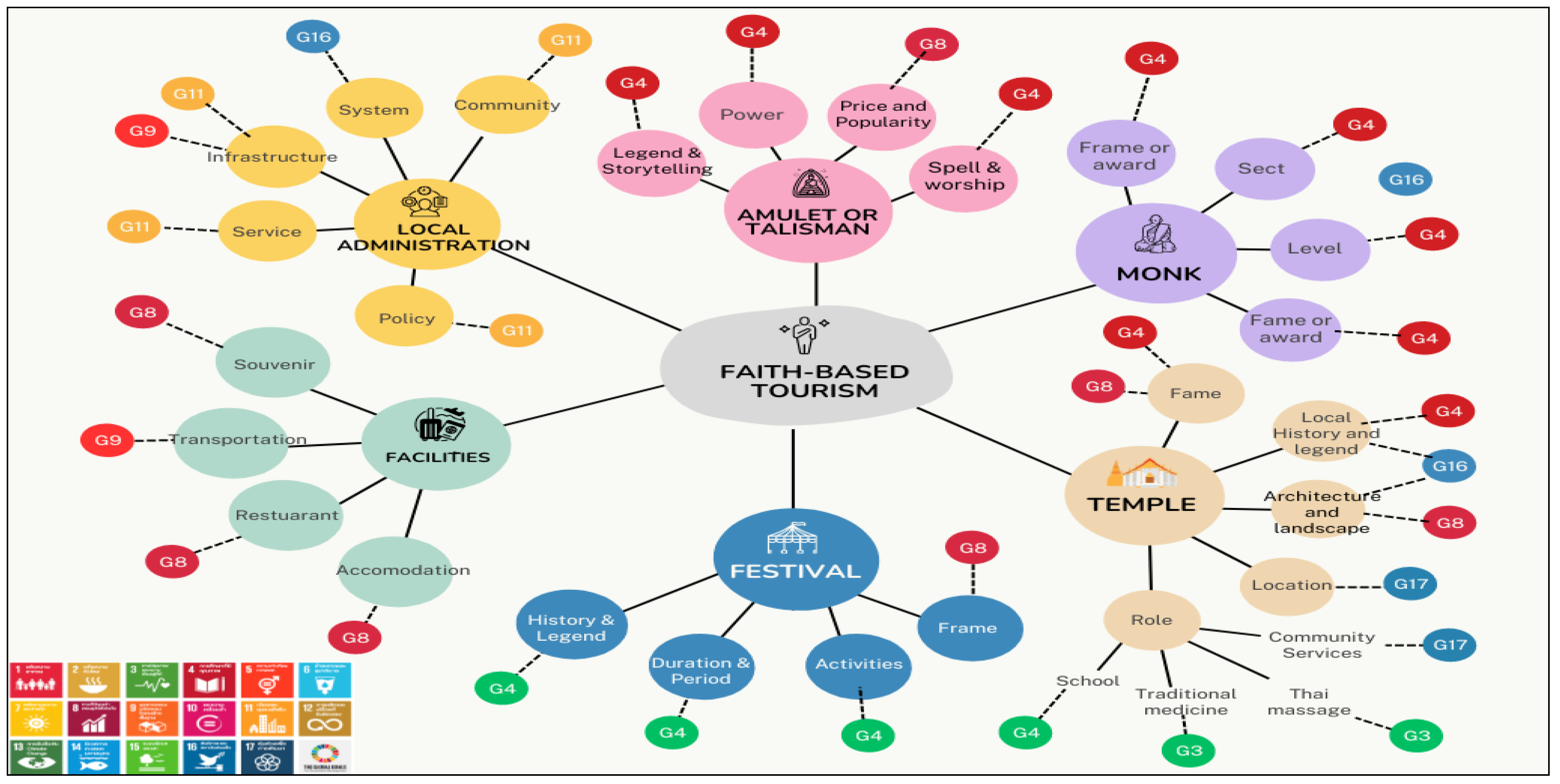
Figure 2.
Data architecture of FaST.
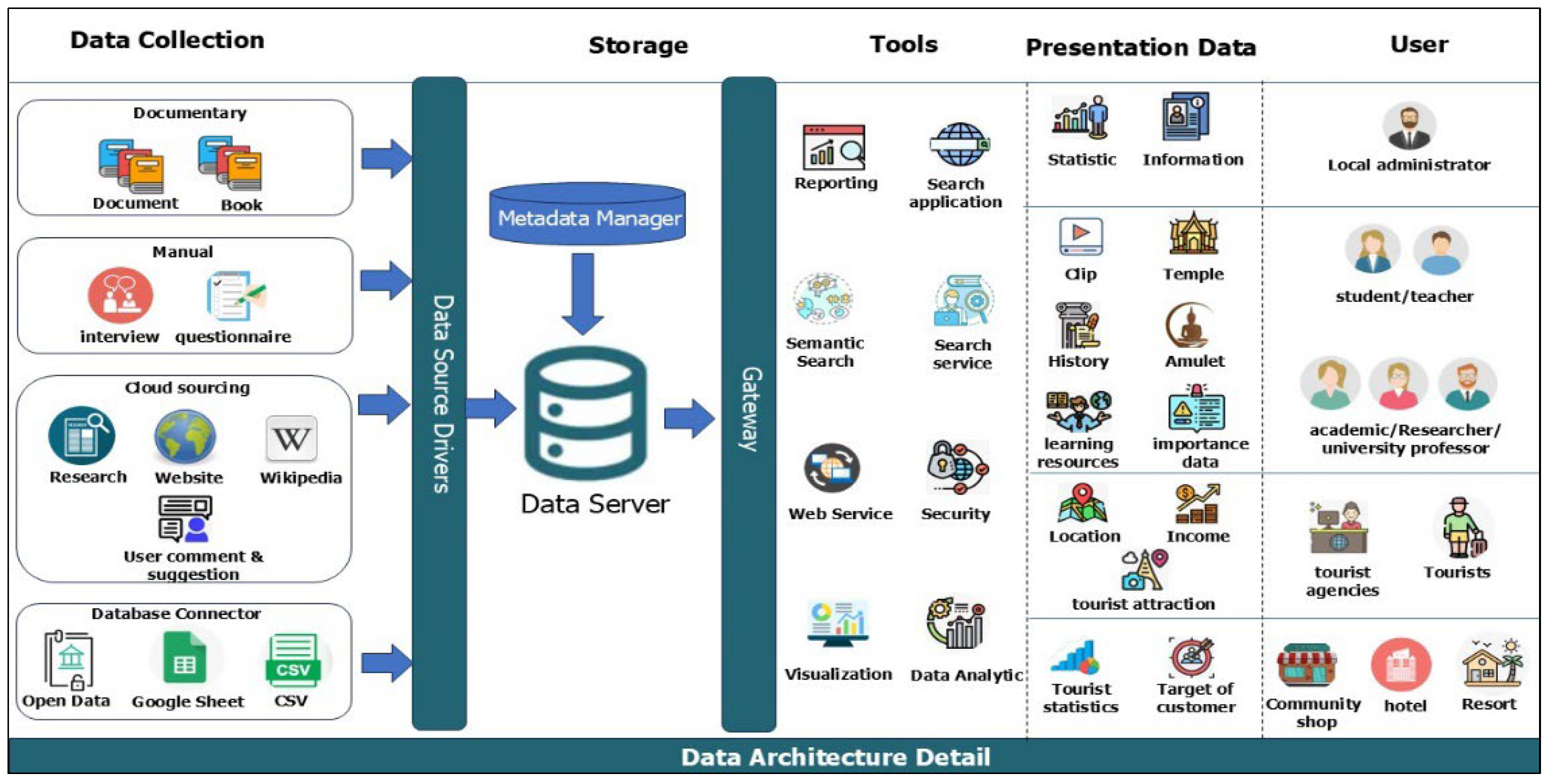
Figure 3.
The metadata elements for FaST system.
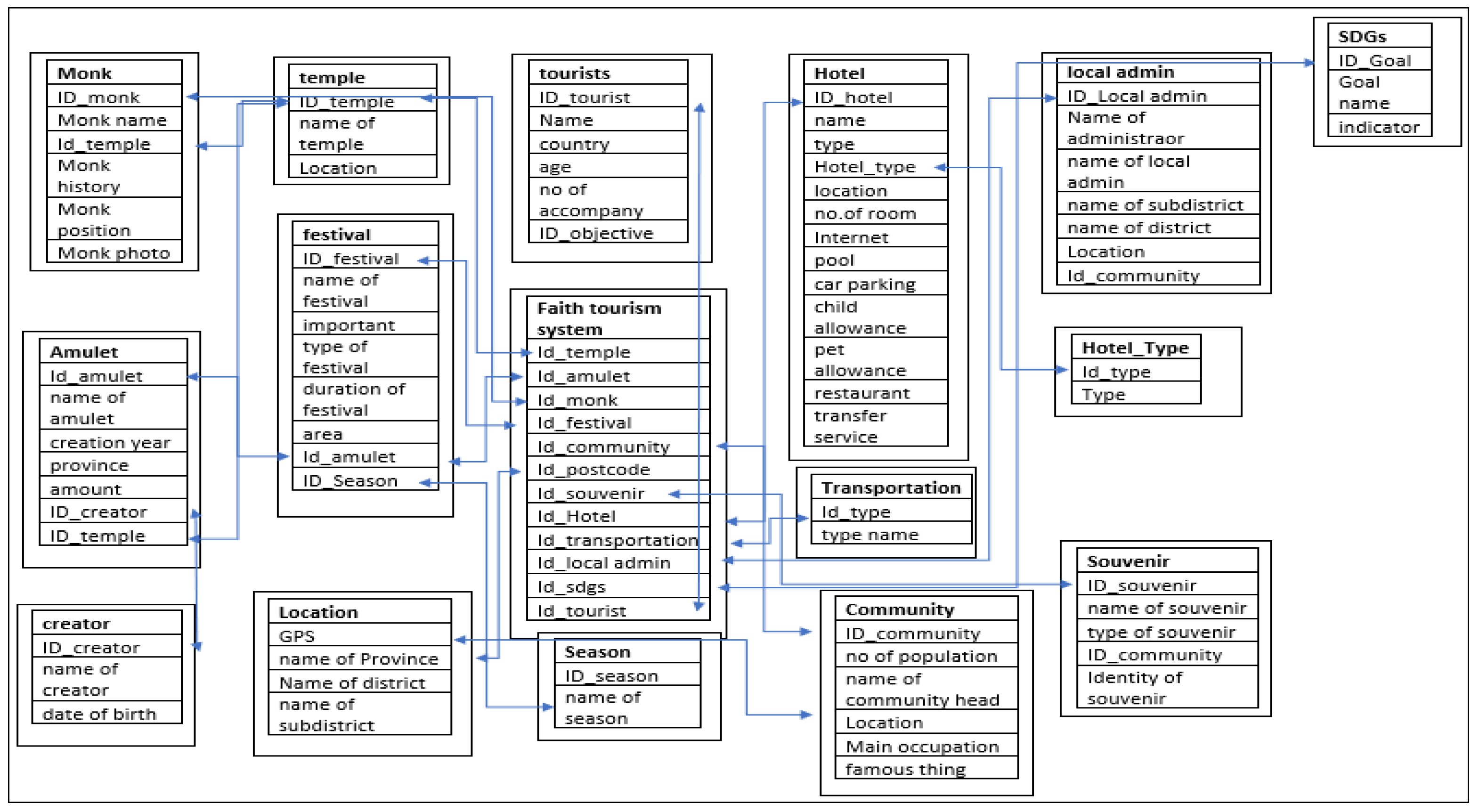
Figure 4.
Showing details of a temple.
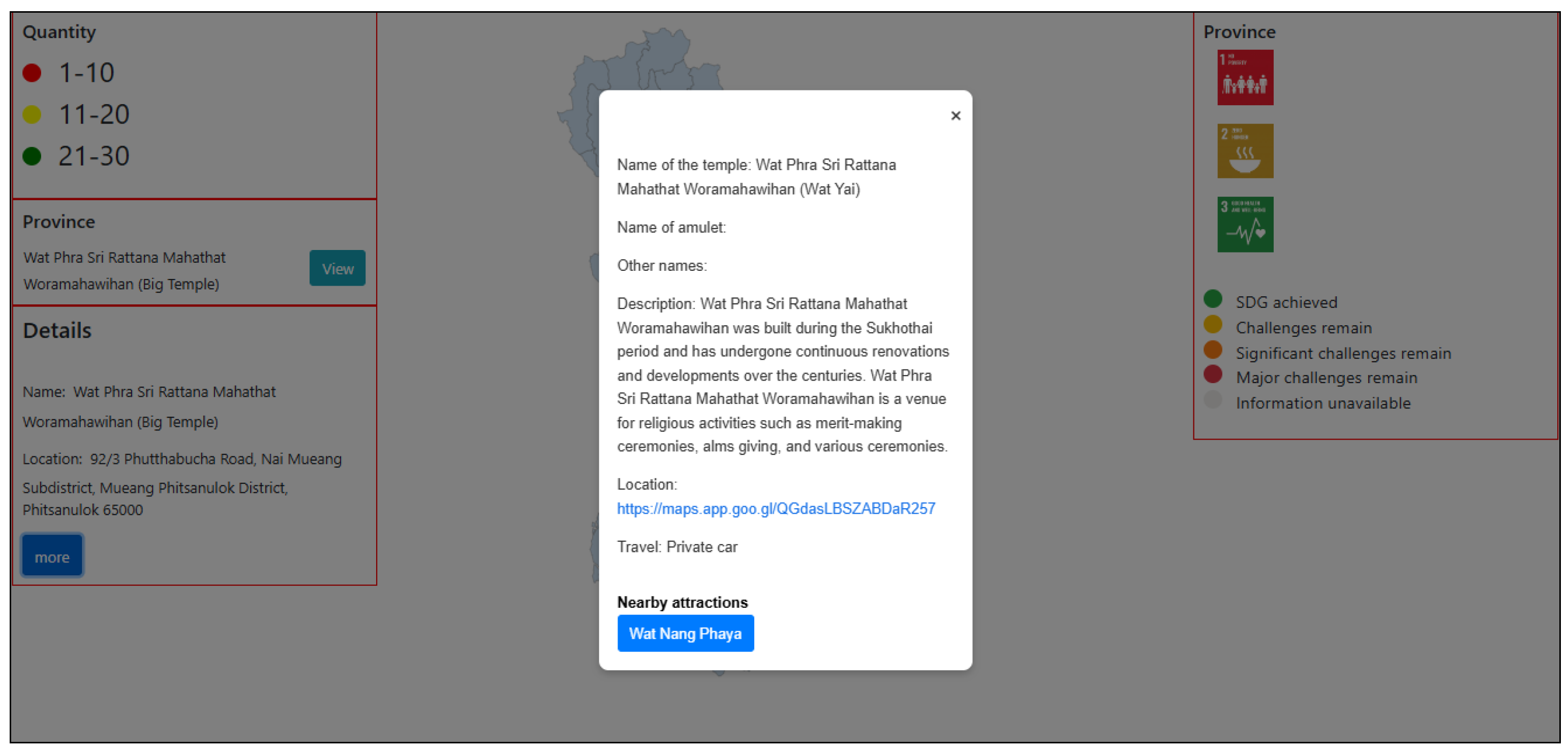
Figure 5.
The landing page of the FaST prototype system.
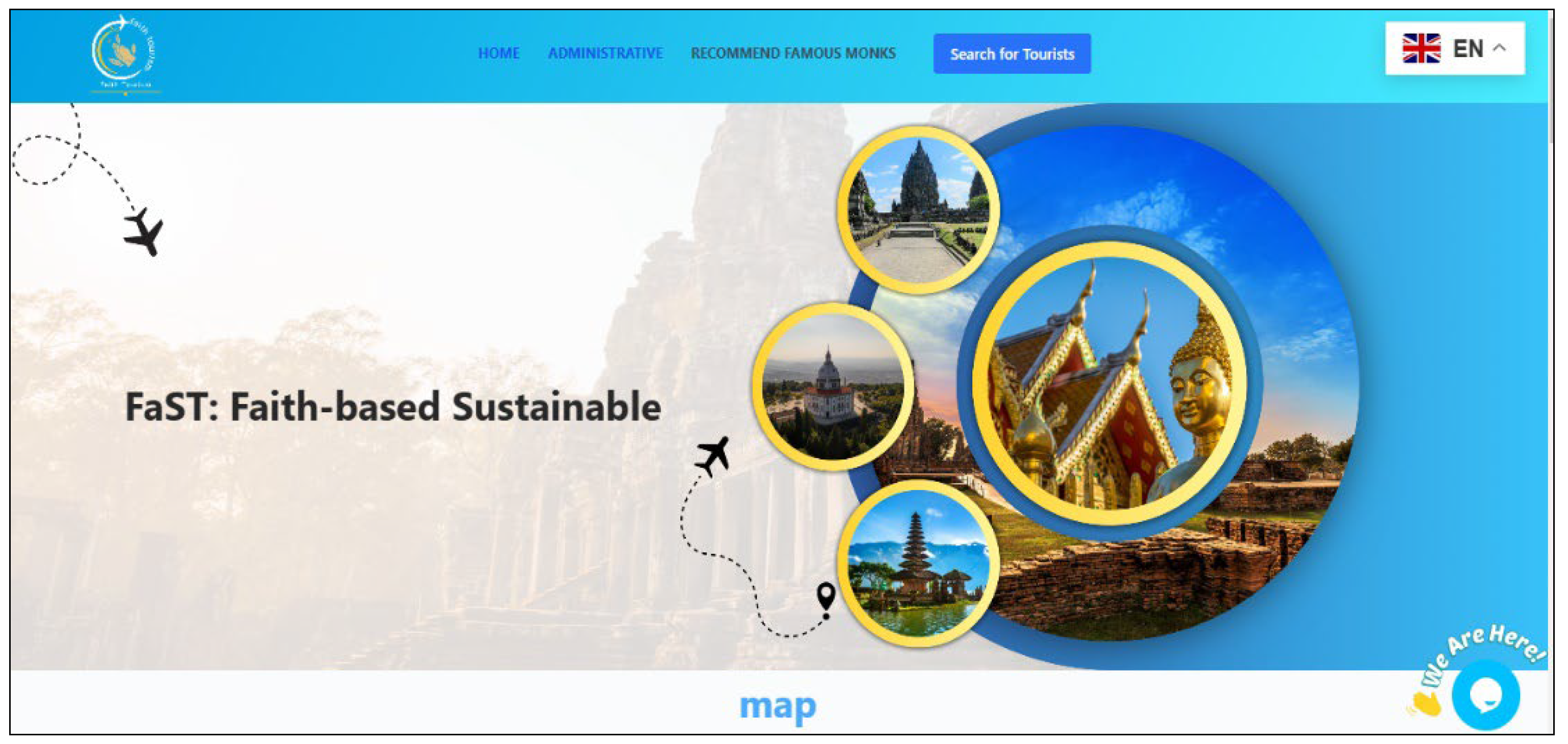
Figure 6.
(a and b): Showing tourist attractions (temples) on the map of Thailand.
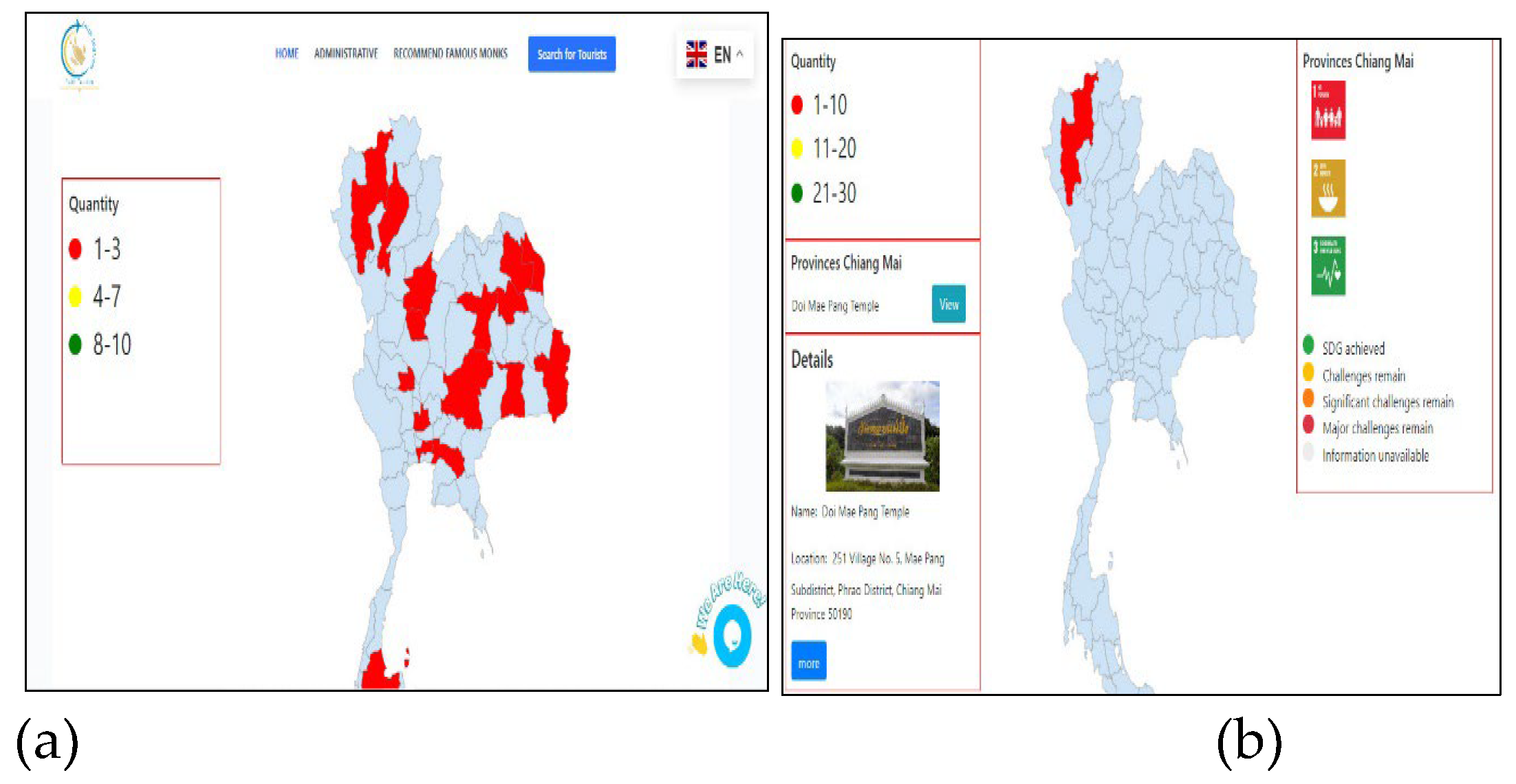
Figure 7.
(a and b): Showing the details of a chosen tourist attraction and monk.
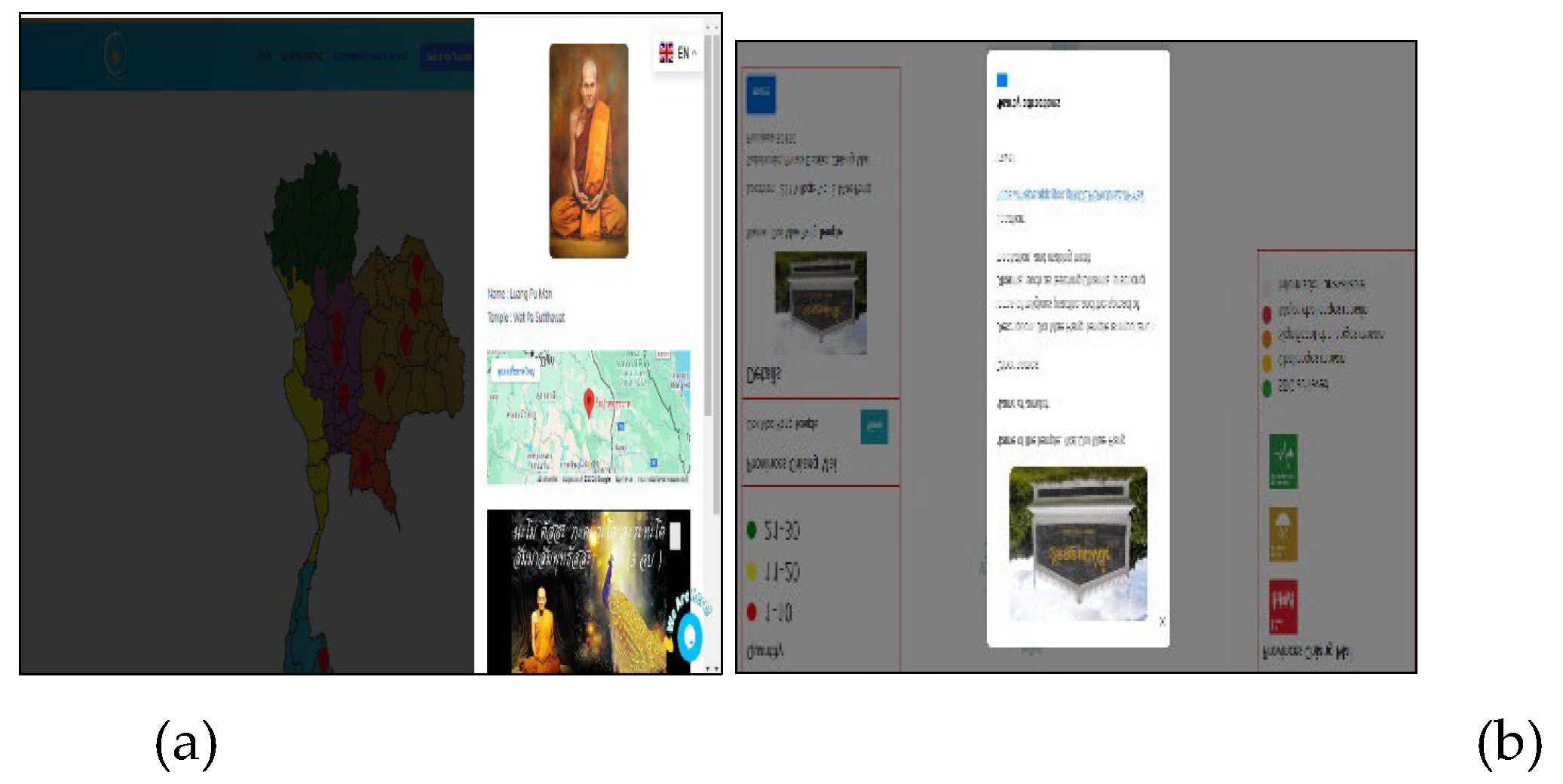
Figure 8.
(a and b): Showing results on research papers related to a tourist attraction.
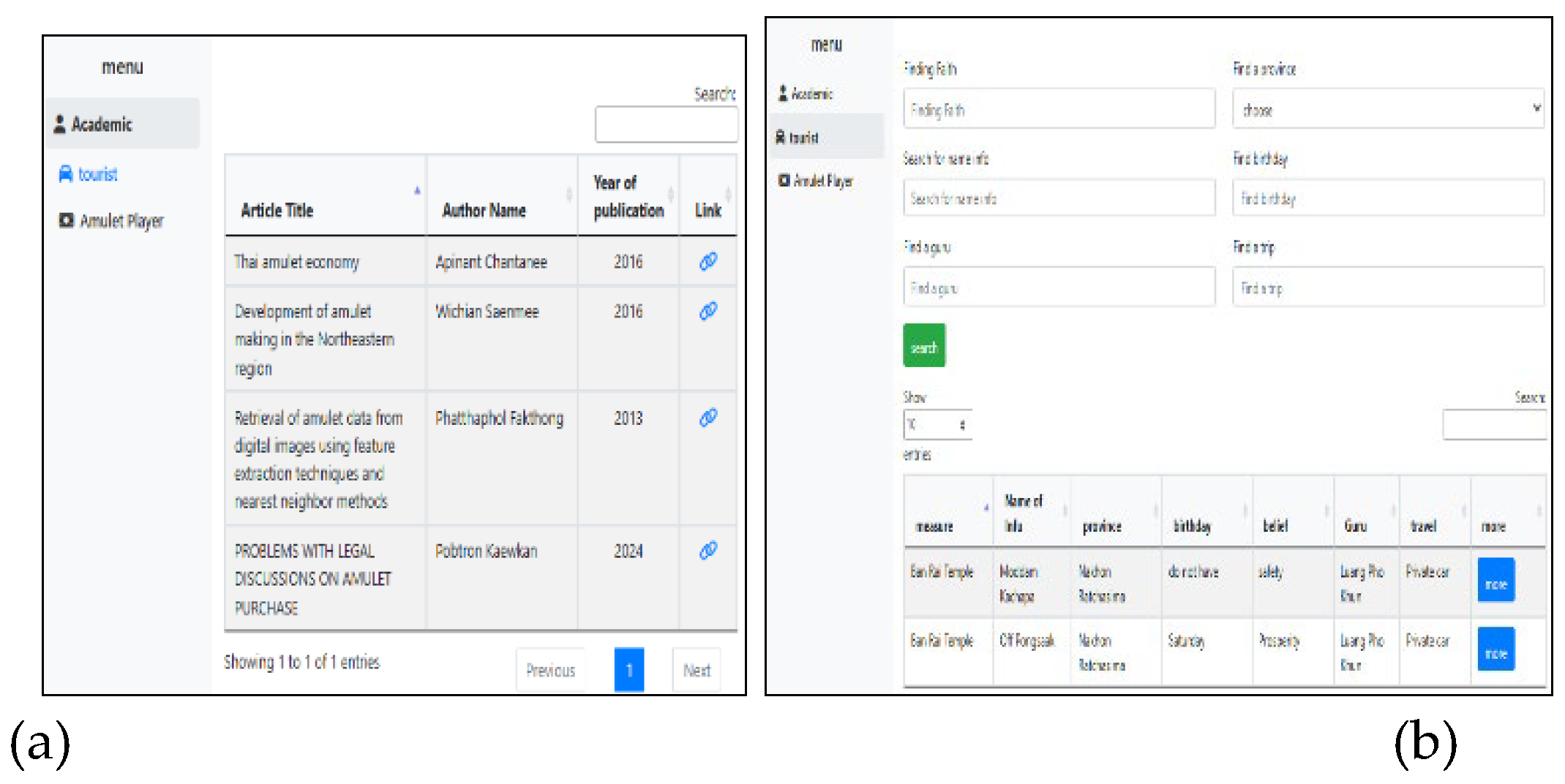
Figure 9.
More information about accommodation at a chosen attraction.
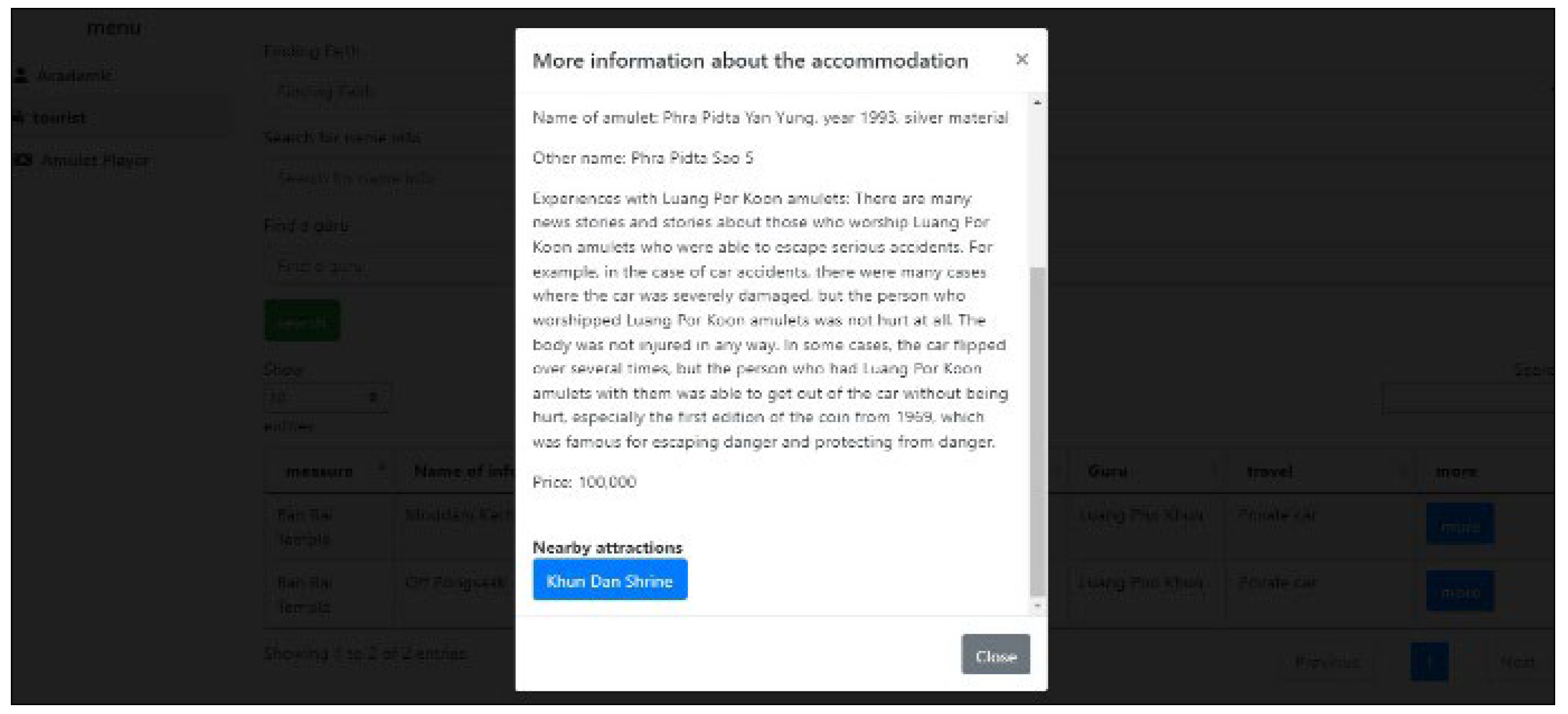
Figure 10.
Detailed information on amulets.
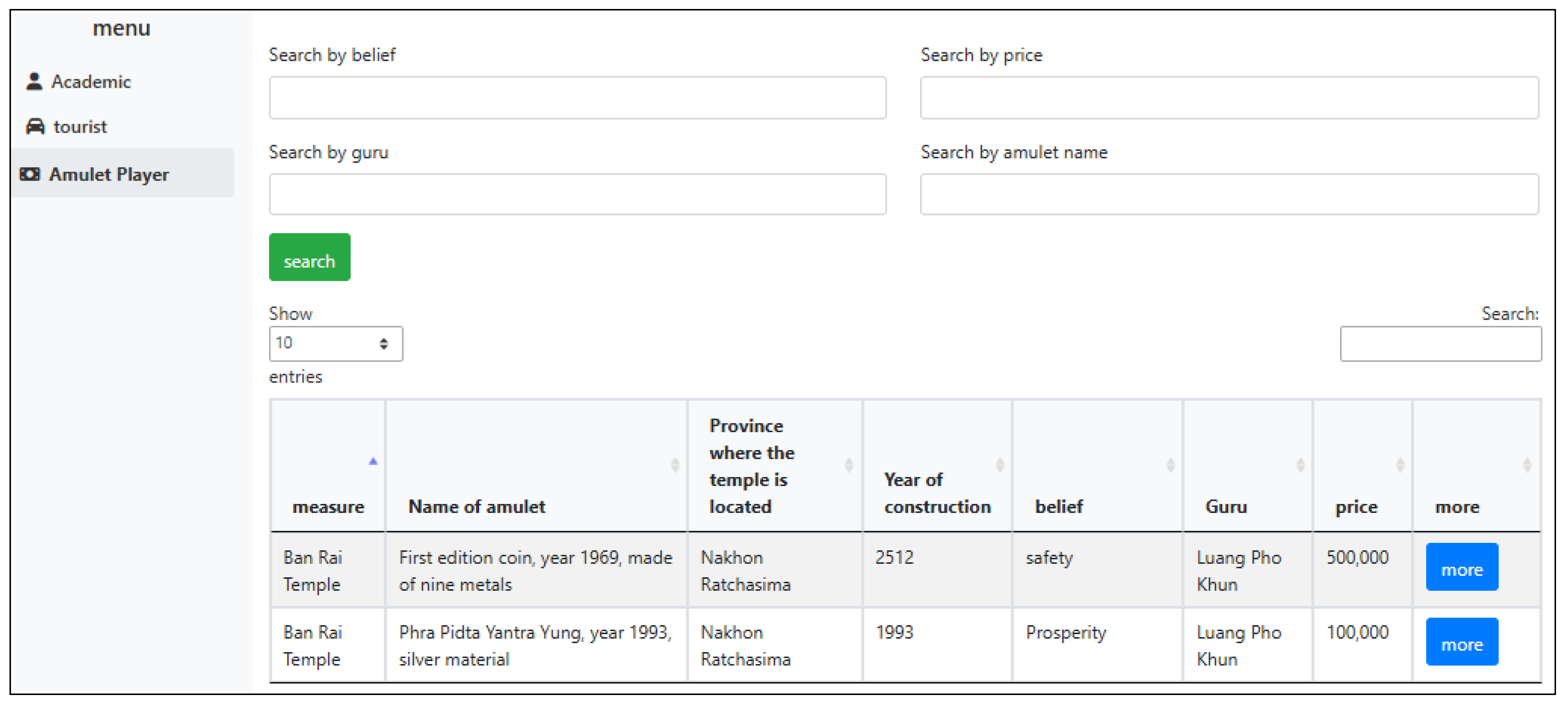
Figure 11.
Results showing different sets of data on tourism.
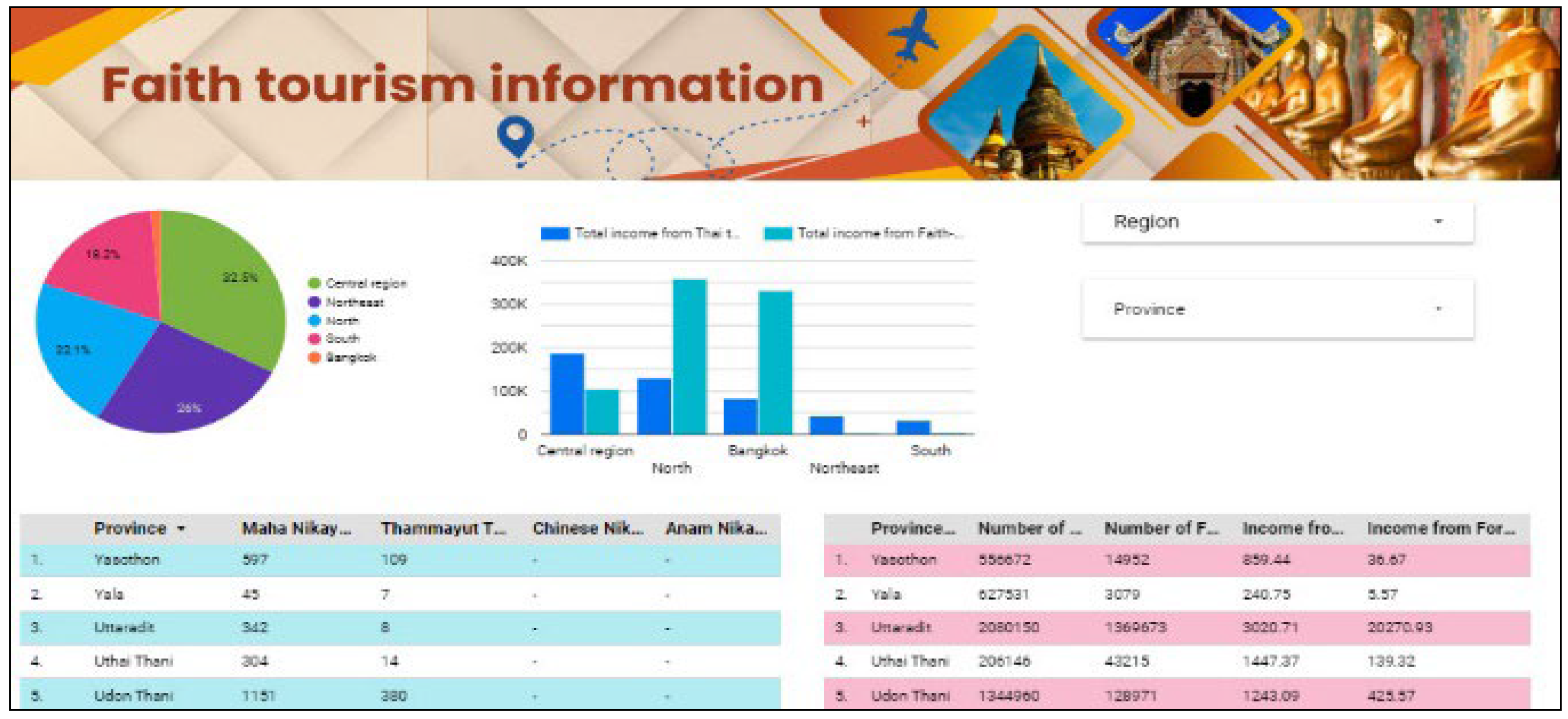
Table 1.
Scenario-based information needs in cultural heritage-based tourism in Thailand.
| Types of persona | Information Needs |
|---|---|
| 1.Tourists | 1.1 Information need: People often choose tourist attractions based on their faith, influenced by stories about the place's sacredness found in the media, internet, and social networks. This behaviour becomes even more prominent when there is a display of opportunities or examples of success achieved through praying to sacred objects. For this, the tourists need information about details of tourist attractions such as topography, climate, surrounding atmosphere, quality of various services that the temple or tourist attraction has prepared for tourists, routes, methods of travel to religious tourist attractions, as well as interesting nearby tourist attractions, sacred objects that may be purchased for worship, methods of paying respect to sacred objects, as well as recommended restaurants, souvenir shops, and hotels. 1.2 Information seeking: Most tourists choose to use the Internet as their information source to meet their needs. It can be a platform or social media for recommending tourist attractions, accommodations, and transportation. 1.3 Information evaluation: The information's reliability will be determined by looking at the ratings and comments of tourists who have had direct experience with these services. |
| 2. Local administration | Local Administrative Organisations have a total of 6 groups of information needs for administration: infrastructure, quality of life of the people in the community, safety of life and property of the tourists, local economy, natural resources, and local wisdom. Information that the local government need for community management in order to respond to faith tourism includes the percentage of roads ready for use, reports on road damage, percentages related to communities and water sources, percentages of population, employment rates, average income, education levels, community shops, and commercial businesses linked with tourism, percentages related to waste separation, waste management of tourist attractions, as well as the number of festivals and events that promote traditions or local wisdom. |
Table 3.
The metadata elements for FaST system.
| Main Element | Description | Sub-element |
|---|---|---|
| 1. Talisman | The name of the amulet or sacred things |
|
| 2. Monk | The names of the venerable monks who are related to in the creation of the amulet or sacred things ceremony |
|
| 3.Tourist site | The names of faith-based tourist attractions may be the names of real places or legendary sites that tourists commonly visit to pay homage, worship, or purchase various amulets, such as Wat Ban Rai and Tham Phaya Naga |
|
| 4.Festival | Important festivals in Thailand that express beliefs about sacred things or various miracles and are popular among both Thai and foreign tourists, such as the Ubon Ratchathani Candle Festival, the Nakhon Phanom Boat Procession, or the Nong Khai Naga Fireball Festival. |
|
| 5. Community | Communities living around faith-based tourist attractions, which benefit from or are affected by the travel of tourists coming to visit or pay homage to these faith-based tourist sites. |
|
| 6.Local administration | Local administrative organizations responsible for managing faith-based tourist attractions |
|
| 7.Infrastructure | Public infrastructure services surrounding religious tourism sites, such as roads, electricity, water supply, internet, bus stations, or airports |
|
| 8.Community business | Community businesses include shops, restaurants, hotels or resort, souvenir stores, and other types of businesses located in the surrounding areas or near faith-based tourist attractions |
|
| 9. Location | The locations of various places such as temples, tourist attractions, restaurants, communities, or local administrative organizations |
|
| 10 SDGS | The 17 Sustainable Development Goals (SDGs) to demonstrate the connections or support for faith-based tourism in various ways. |
|
| 11.Link data | The data linking to relevant information in different formats where relevant and linked to the amulet information in the system |
|
Disclaimer/Publisher’s Note: The statements, opinions and data contained in all publications are solely those of the individual author(s) and contributor(s) and not of MDPI and/or the editor(s). MDPI and/or the editor(s) disclaim responsibility for any injury to people or property resulting from any ideas, methods, instructions or products referred to in the content. |
© 2024 by the authors. Licensee MDPI, Basel, Switzerland. This article is an open access article distributed under the terms and conditions of the Creative Commons Attribution (CC BY) license (http://creativecommons.org/licenses/by/4.0/).
Copyright: This open access article is published under a Creative Commons CC BY 4.0 license, which permit the free download, distribution, and reuse, provided that the author and preprint are cited in any reuse.
Downloads
83
Views
34
Comments
0
Subscription
Notify me about updates to this article or when a peer-reviewed version is published.
MDPI Initiatives
Important Links
© 2025 MDPI (Basel, Switzerland) unless otherwise stated






